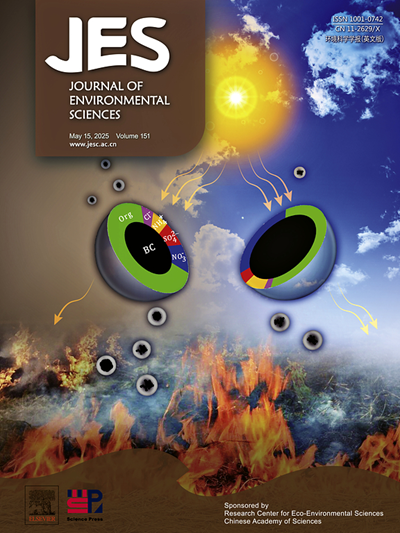华北高海拔大气腐殖质样物质(HULIS)的特征:丰度、分子组成和光学性质
IF 5.9
2区 环境科学与生态学
Q1 ENVIRONMENTAL SCIENCES
引用次数: 0
摘要
大分子化合物HULIS(腐殖质样物质)的光学吸收可以显著影响气溶胶的光吸收和辐射强迫,从而影响云凝结核的形成,从而影响气候和大气环境。本研究收集了中国北方泰山山顶的气溶胶(PM2.5)样本,研究了HULIS的浓度、分子组成和光学性质。研究区PM2.5中HULIS的平均浓度为1.26±0.54µg/m3,占水溶性有机碳(WSOC)的56%,低于城市地区,但高于其他山区。质谱分析表明,CHO和CHON组分具有高芳香性和酚基,是吸收和荧光的主要贡献者。这些结果表明,HULIS主要由木质素和蛋白质/氨基糖组成,来源于燃烧和二次生成,具有较高的光吸收能力(MAE365(质量吸收效率)和AAE (Ångström指数)指数分别为0.62 m2/g和4.99)。平行因子分析鉴定出HULIS的三种荧光成分,低氧腐殖质样物质占60.8%,高氧腐殖质样物质占21.0%,蛋白样物质占18.2%。本研究强调了泰山光晕的吸光能力和次生形成的重要性,为研究光晕的气候效应、形成机制和来源奠定了基础。本文章由计算机程序翻译,如有差异,请以英文原文为准。

Characterization of atmospheric humic-like substances (HULIS) at a high elevation in North China: Abundance, molecular composition and optical properties
The optical absorption of large molecular compounds HULIS (humic-like substances) can significantly impact the aerosol light absorption and radiative forcing, influencing cloud condensation nuclei formation and thus the climate and atmospheric environment. This study collected aerosol (PM2.5) samples from the summit of Mount Tai in North China to investigate the concentration, molecular composition, and optical properties of HULIS. The average concentration of HULIS in the PM2.5 in this study was 1.26 ± 0.54 µg/m3, comprising for 56 % of the water-soluble organic carbon (WSOC), with levels lower than urban areas but higher than other mountainous regions. Mass spectrometry revealed that CHO and CHON components, with high aromaticity and phenolic groups, are major contributors to absorption and fluorescence. These results indicate that HULIS is mainly composed of lignin and proteins/amino sugars, derived from combustion and secondary formation, and possesses a high light absorption capacity (with MAE365 (mass absorption efficiency) and AAE (Ångström exponent) indices of 0.62 m2/g and 4.99, respectively). Parallel factor analysis identified three fluorescence components of HULIS, with proportions of 60.8 % for less oxygen humic-like substances, 21.0 % for high oxygen humic-like substances, and 18.2 % for protein-like substances. Our study highlights the significance of the light-absorbing capacity and secondary formation of HULIS at Mount Tai, laying the groundwork for investigation into the climate effects, formation mechanisms, and sources of HULIS generation.
求助全文
通过发布文献求助,成功后即可免费获取论文全文。
去求助
来源期刊

Journal of Environmental Sciences-china
环境科学-环境科学
CiteScore
13.70
自引率
0.00%
发文量
6354
审稿时长
2.6 months
期刊介绍:
The Journal of Environmental Sciences is an international journal started in 1989. The journal is devoted to publish original, peer-reviewed research papers on main aspects of environmental sciences, such as environmental chemistry, environmental biology, ecology, geosciences and environmental physics. Appropriate subjects include basic and applied research on atmospheric, terrestrial and aquatic environments, pollution control and abatement technology, conservation of natural resources, environmental health and toxicology. Announcements of international environmental science meetings and other recent information are also included.
 求助内容:
求助内容: 应助结果提醒方式:
应助结果提醒方式:


